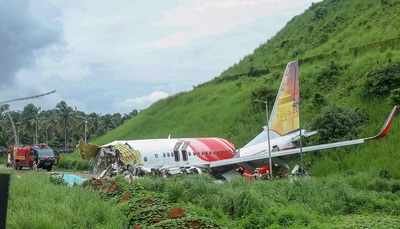
MUMBAI: Photographs of the wreckage of the ill-fated Air India Express Boeing 737, especially those of the cockpit control panels and aircraft engines, suggest the pilots attempted a take-off or go-around after a deep touchdown on the tabletop Calicut runway, said a senior pilot.
However, that’s still a theory, say experts. The accident could have occurred due to other factors, details of which will emerge only in the investigation report.
“The wreckage of the cockpit shows the throttle in the fully forward position, which is the take-off/go-around position. The spoilers are retracted from the position of the speed brake lever, whereas in an aircraft trying to come to a halt after touchdown the spoilers should have been fully extended,’’ said an aviation source.
Spoilers are panels on the top of the wings which when raised or deployed, reduce the speed of the aircraft. However, the flaps (panels mounted on the rear edge of the wing, which can be raised or lowered from the cockpit to increase lift—the drag produced by the wings) are still in landing configuration. “A possible explanation is that the pilots might have forgotten to put the flaps in take off/go-around configuration. Flaps in landing configuration can hinder the attempts to lift off,’’ said an engineer.
If the accident investigation report reveals that the pilots did attempt to take off again after the brakes were applied post touchdown, then the Calicut crash will have a number of similarities with the 2010 crash of an Air India Express flight in Mangalore. The similarities would be in the series of actions taken by both sets of pilots post the late touchdown on tabletop runways. An aircraft can certainly take off go around safely post touchdown, provided the action to do so is taken swiftly after touchdown and most importantly, before action to slow down the speed of the aircraft speed—like applying brakes—is taken.
Unlike the Mangalore crash, in the case of the Calicut accident, the aircraft did not catch fire post impact. It was speculated that the AIX pilots had probably switched off the fuel supply to cut off the engines and prevent a possible fire. “But in the cockpit photographs, the fuel control switches are not in the cut-off position, which means the engines were running on impact,’’ the source aviation added. Also, unlike the Mangalore crash, where the Boeing 737 aircraft fell into a 300-feet gorge off the runway end, in case of Calicut the terrain drops to only 35-40 feet, which would explain the comparatively lower casualties, he added.
The Air India Express pilots apparently missed the touchdown zone and landed about 3,000 feet deep into the Calicut runway in tailwinds. “But the runway is long enough and so a deep touchdown by itself doesn’t entirely explain why the aircraft went off the tabletop runway to fall off the edge and crash,’’ said a senior commander. “There has to be a host of other factors for such an accident to occur,’’ he added.
Irrespective of what the investigation throws up, what needs to be highlighted here,s ay aviation experts, is that pilots take split-second decisions during a landing. The final landing phase which begins after an aircraft has crossed the runway threshold is completed in less than 15 seconds. During this time, the aircraft crosses the runway threshold, does a landing flare (floats over the runway to reduce descent rate and achieve a smooth touchdown) and touches down; the sequence includes applying different modes of braking to ensure the aircraft systematically decelerates and comes to a halt before the end of the runway.







More News
7. Is it time to reopen schools?
Family loyalists slam dissenters, say timing of letter ‘insensitive’ | India News – Times of India
Filipina beauty queen distributes homemade desserts to support her family – BeautyPageants